A visit to Bhutan for a friend’s wedding brings rest and spiritual Peace
When my college best friend Jamyang invited me to her wedding in Bhutan, I excitedly said yes. My parents, however, were less than enthused. My dad, preceeding the days leading to my departure, showed me videos on YouTube of flights landing and taking off from Paro Airport. “Look at how steep the mountains are!” he said. As an adrenaline junkie, I was secretly looking forward to the experience.
On the day of my flight, I was excited, albeit stressed by the workweek and impending airport transfers. A flight to Bhutan can only take off from either India or Bangkok, so I chose the Bangkok route from Suvarnabhumi Airport. I landed in Bangkok at night, and like a true millennial traveler, spent the night in Hotel Boxtel at Suvarnabhumi Airport. The room was a little bigger than the bed and the bathroom was the public airport toilet, but the bed was soft and the sheets were clean, and it was a better option than sleeping in an airport chair or leaving the terminal for another hotel.
Because of Bhutan’s mountainous region, flights to and from are restricted from sunset to sunrise. My Bhutan Airlines flight was the early morning option, just in time for Jamyang’s religious ceremony. The flight was smooth sailing, with a tasty Indian dish for breakfast. Jamyang reassured me that Prince William and Kate Middleton, on their trip to the landlocked Himalayan region, had no problems landing. Indeed, the pilots who fly Bhutan Airlines and Druk Air (the other national airline) are some of the very best in the world, with training specifically geared for the mountainous area.
First Sight of the Mountains
A whiff of fresh mountain air was just what I needed as I stepped off the plane. Paro Airport may not be like the sleek and bustling hub of Suvarabhumi or Changi in Singapore, but it has its own intimate charm.
The Bhutanese government is very welcoming to tourists but because they want to prevent their country from hoards of hapless travelers, there is a high cost in return. Trips can only be booked through a recognized tour company, with each day costing around $250. That includes hotel, tour, tour guide, driver, food and transportation. This ensures that travelers to Bhutan are more discerning and are genuinely interested in the country, more likely to treat it with respect.
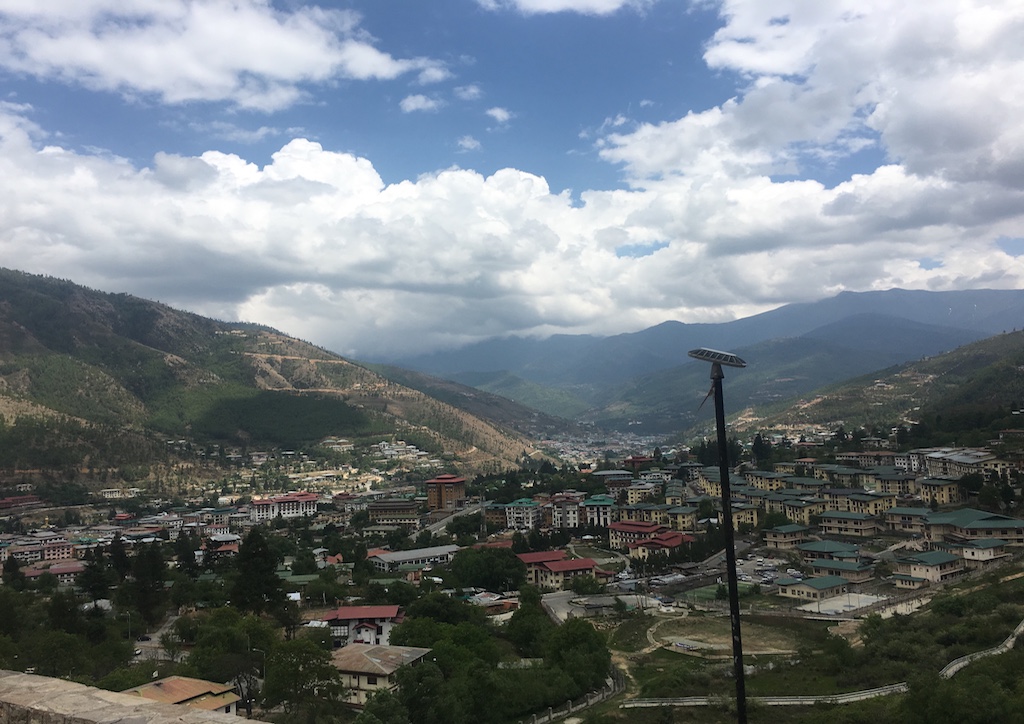
Buying Asparagus on the Side of the Road
On my way to Thinpu by car with Thinley, another college friend, a few things became apparent to me. In Bhutan, the lush, rolling hills are untouched by billboards. The only signage is the occasional photo of the Royal Family, and funny road signs with witty and pun-tastic sayings like, “After drinking whiskey, driving is risky,” or “If you are married, divorce speed.” This is a venture by the Boarder Roads Organisation (BRO) to promote road safety.
Driving in Bhutan is much like driving through Baguio, with the occasional cows crossing the street. Thinly stopped the car and bought asparagus on the road from a single vendor. The very idea of buying produce on the side of the road seems anathemic, something we would never do in the Philippines because we’d worry about its provenance, but Thinley assured me this is very much a norm and very safe.
In the city of Thimpu, I noticed that all the buildings look the same. This is a government rule, to ensure uniformity of all the structures. Not only are you in awe of the untouched natural landscape, all the buildings stand in unison as well. Thinley pointed out the first “mall” in Bhutan. This structure of no more than three stories is smaller than malls in Manila, and when it opened in 2008, it also happened to be the first building with an escalator. Years ago, Jamyang said people wouldn’t even ride on it a few years back, they’d just stare at it as it went up and down. For those curious, televisions in Bhutan were only allowed as late as 1999.
This is not to say that Thimpu doesn’t have a thriving shopping scene. It does, but most stores are street-level structures, inviting people to walk in and out, and ensuring a non-traffic situation. Unlike in Manila, where malls are built alongside EDSA and create choking-points on the thoroughfare, the lack of major structures alongside the main highway of Thimpu means traffic resembles that of Manila on a Sunday.
I checked in at the Ramada Valley Hotel, a charming boutique hotel also owned by the groom’s family. My room overlooked the grounds where the reception would be held, three days from the day I arrived. Already, there was a sense of bustling excitement as tents and tables were set up. My room resembed that of a traditional Bhutanese bedroom, with intricate paintings on the cabinet and ceiling.
RELATED READS: The Hobbiton Movie Set in New Zealand is One of the Most Magical Places on Earth
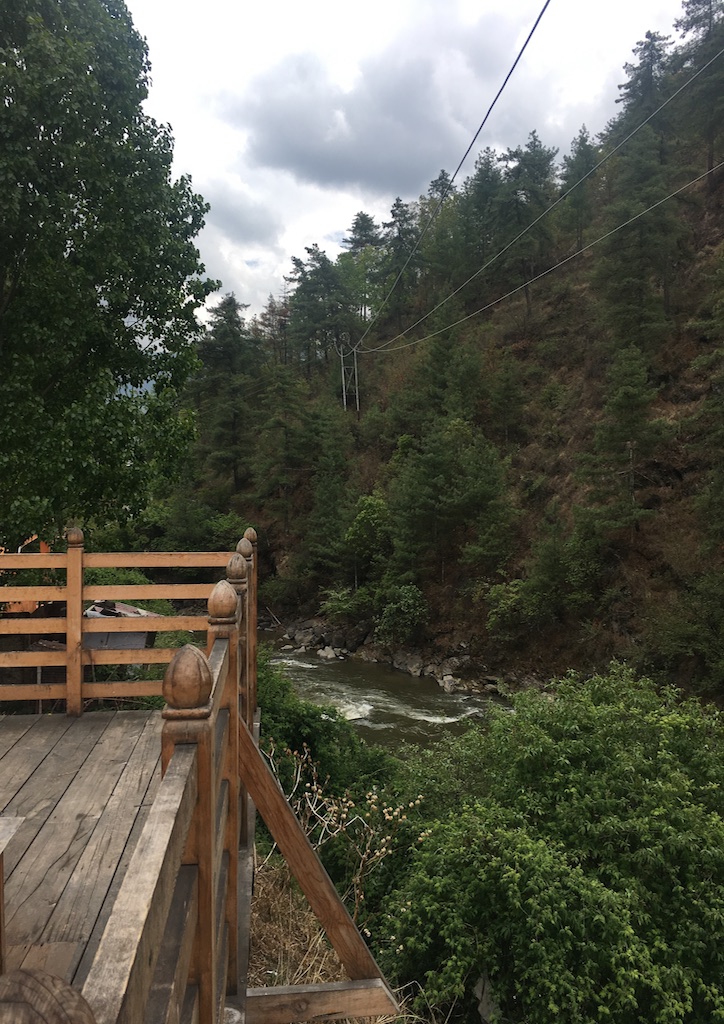
A Happy Reunion
Thinley helped dress me up in Bhutan’s national dress. For women, the kira is an ankle-length skirt made of woven fabric and Kezang exchange rings and cut the cake. Thinley pointed out members of the royal family and the high level government officials present. It was a well-attended affair.
After pictures and drinking, we said goodbye to the happy (and exhausted) couple. I went to the hotel and took a nap, waking up just in time for dinner—a delicious Indian buffet. A huge fan of paneer dishes, I devoured my meal, and washed it down with the first of many cups of masala chai.
Missing Zac Efron by a Hair
The next day, Thinley and I had lunch at Clove Cafe. Thinley is an architect (also married to a fellow architect who studied in the University of the Philippines), and one of her projects was the design of Clove, a casual dining option that served Bhutanese and Western fare. I had my first try of ema datshi, the country’s national dish. Made of chilli pepper and melted cheese, it was spicy and savoury, just the kind of food I enjoy.
We walked around downtown Thimpu, a bustling section of streets with restaurants and shops. I purchased the khadar I would give for the wedding reception, then helped Thinley look for a wedding gift. As we walked around, Thinley mentioned that people preferred driving more than walking in Bhutan, and in recognition of that, the government makes it easier for citizens to purchase electric cars, rather than big, bulky gas-emitting options.
We walked to CDK Boutique, a shop owned by Chandrika Tamang, a young Bhutanese designer whose designs are inspired by nature and the environment. Clothes are traditional fabrics in Western designs, and I happily purchased a raw silk jacket.
At dinner with Jamyang and her family, I learned that Zac Efron was also in Bhutan. Unfortunately, we didn’t run into him. He was at Paro Taktsang (Tiger’s Nest), the number one tourist attraction in Bhutan. Built onto the side of a cliff, the monestary offers beautiful views of Bhutan’s wondrous natural landscape. Unfortunately, it is a hard hike to get to, and I had no time to visit. Apparently, all Bhutanese people must visit it at least once in their lifetime.
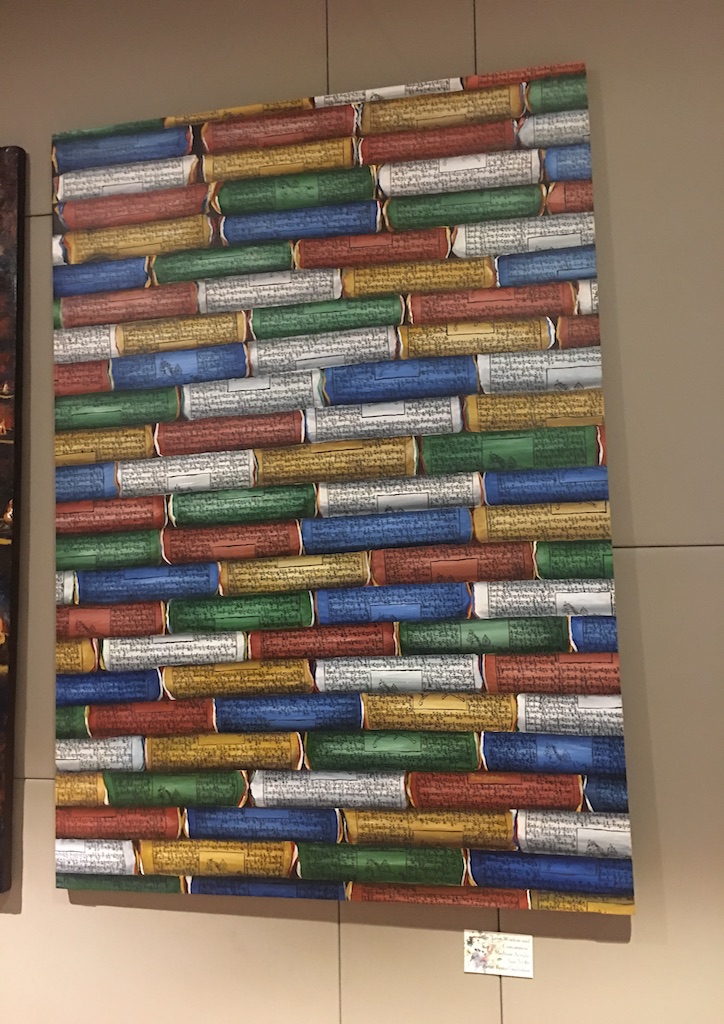
The Local Arts Scene
After breakfast the next day, I strolled around the surrounding area. I walked by the side of the highway, where the sound of cars didn’t drown the sound of the river. After my walk, I attended an art exhibition opening at Le Méridien with Thinley. Themed “The Colors of Love,” the show featured works of 19 Singaporean artists from Aspiration Fine Arts and nine artists from VAST (Voluntary Artists Studio Thimpu) in Bhutan. Her Royal Highness Princess Dechen Yangzom, one of the princesses of Bhutan was present.
Asha Karma, the founder of VAST, said he was thankful for the collaboration of both countries. “We all love art. Art provides an opportunity to be ourselves, to be calm and bring us together.” Works by young Bhutanese artists like Pema Gyeltshen and Chand Bhattarai showed the current direction of Bhutanese contemporary art. “As a torchbearer of contemporary arts, I hope all artists, young and old, continue to dedicate soul and energy to take the frontier of contemporary art to new heights without compromising our age-old traditional art,” said Karma.
RELATED READS: Check This Out: This Hotel in the Costa Rican Jungle Was Built Inside a Vintage Airplane
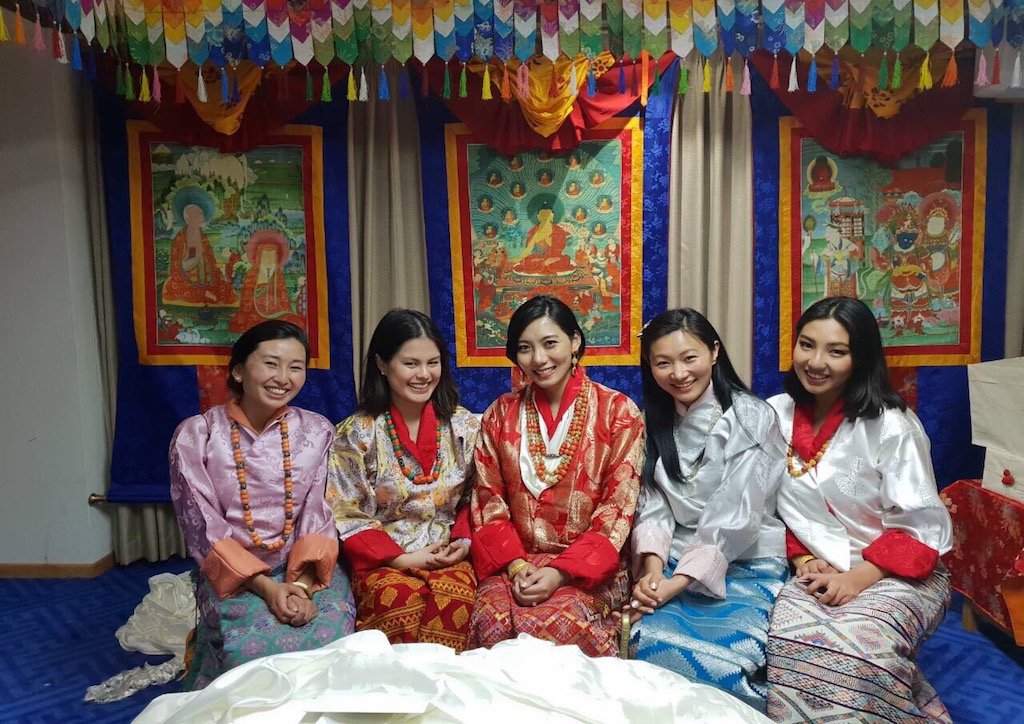
Royal Encounters
Following the art exhibit, it was time to get ready for the wedding reception. Dressed in one of Thinley’s mom’s fancier kira, we once again lined up to give Jamyang and Kezang the khadar and to hand over our gifts. When I was at the head of the line, two princesses, and then a government official had to go first. So I had to scoot to the side every time. After I finally gave my khadar to the bride and groom, I proceeded to the courtyard, where guests were watching the traditional dancing and enjoying the food.
When the married couple joined us and changed into their Western style clothing for their first dance, we changed as well. We hit the dance floor, and all the aunties enjoyed 80s disco music. It eventually changed to the top 50 hits, then the party really, and truly started.

Making It Up to My Fitbit
The next day, Thinley and her husband took me to the top of the city. We visited Tashichho Dzong, a Buddhist monastery and fortress that is also the administrative seat of the national government, housing the King’s office and throne room. At night, the lights are lit with red, resembling a Transformers robot.
We drove to Buddha Point, home of the Great Buddha Dordenma statue, a gigantic Buddha built on the mountains of Thimpu to celebrate the 60th anniversary of the fourth king Jigme Singye Wangchuk. Made of bronze and gilded in gold, the statue stands at 169 feet and is one of the largest Buddha rupas in the world. The entire site took nine years to finish and fulfills two prophecies by renown Buddhist spiritual leaders, who prophesied that a large statue would be built in the area to bestow good tidings and peace to the entire world.
The imposing site seemed to have more than 100 steps to the top. At night, the steps start to look the same, so I eventually had to walk to the side and hang on to the walls, because there were no railings to get to the top. The view at the top made the journey worth it. Looking down at the lit up city of Thimpu, I was suddenly struck by how lucky I was to be there. Bhutan, sometimes called a hermit kingdom and a country that makes it hard for the average person to visit, was a place I got to visit for a few days, and had enjoyed every moment of.
We walked around the complex. At night, it is besiged by an almost eerie, yet peaceful silence. We were literally touching the clouds. The giant gold Buddha was an imposing reminder of the power of the human spirit to want to build. By the time we walked down the steps, I checked my fitness app and it showed that I had done most of my walking by 10:30 that night.
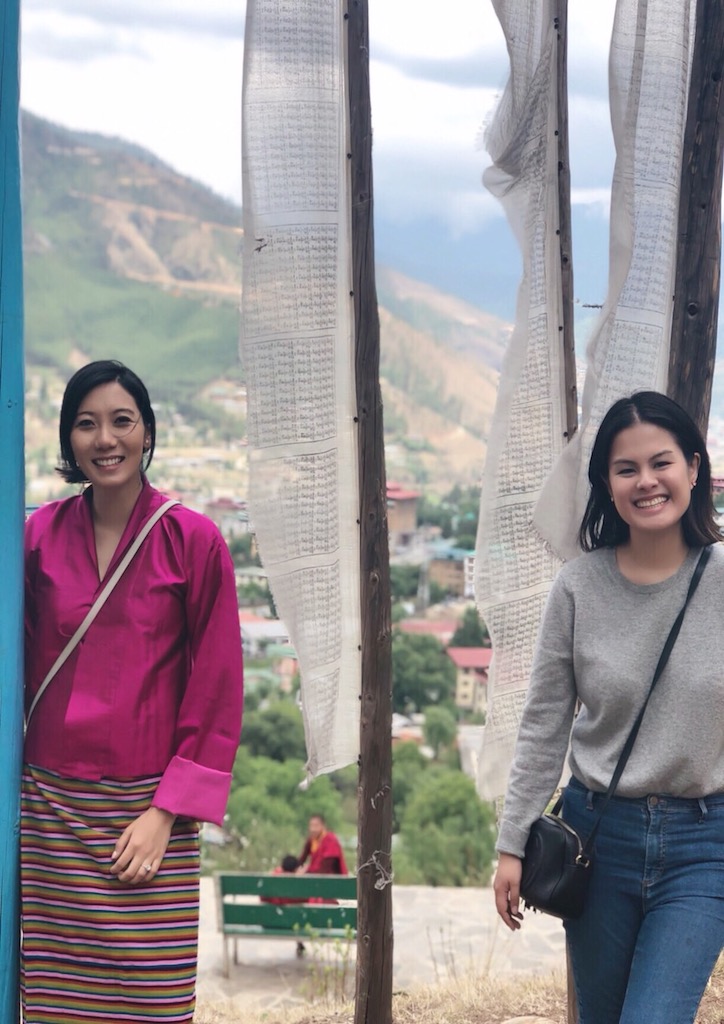
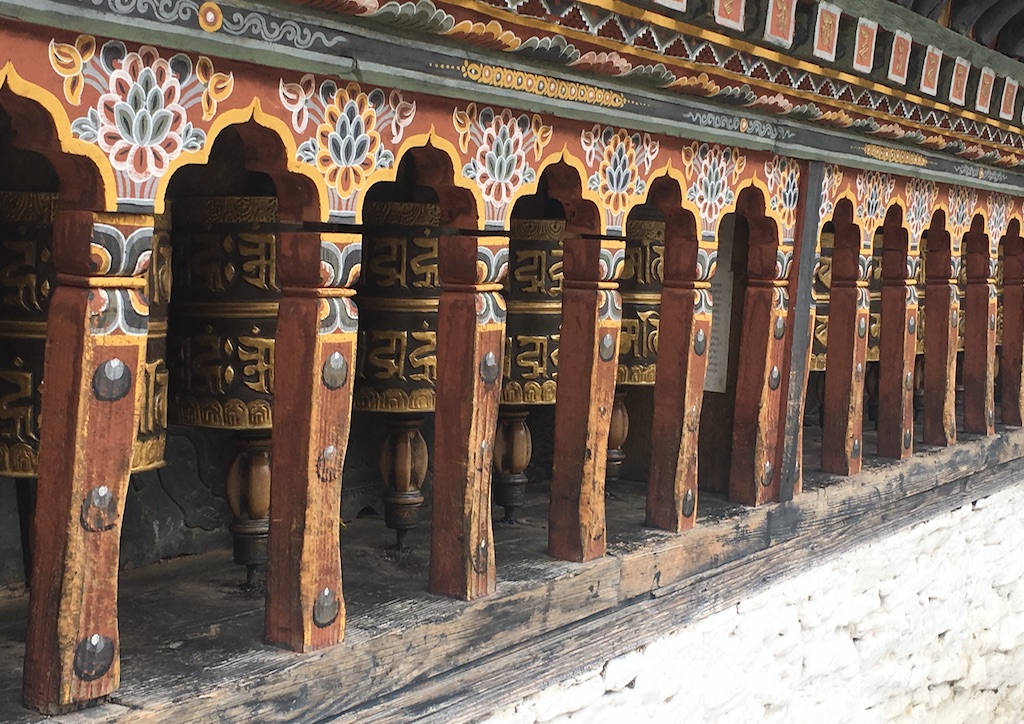
A Day for Blessings
My last day in Bhutan was spent touring sites. We visited Changangkha Lhakhang, a temple perched on a ridge overlooking central Thimpu. Built in the 12th century, new parents come here to get blessings or names for their babies. When I was told to do the religious motions, I gladly obliged. I gave my wishes: success for an upcoming cover shoot, success in my romantic life, and happiness for Jamyang’s marriage and future family.
I asked the astrologer a question. He rolled the dice, and when the dice gave me a good number, it meant my question was answered. After, I rolled the giant and smaller prayer wheels surrounding the temple, and observed that it must be so easy for Bhutanese people to be spiritual and physically fit, considering all the climbing of steps and rolling of wheels they do. The pilgrim path in front of the temple offered amazing views of the city.
We had lunch at the Folk Heritage Museum, where the food was traditional Bhutanese. I had sikkam paa, which kind of tastes like bacon, momos (dumplings), more ema datshi, and other fresh vegetables. They also served butter tea, a traditional drink enjoyed in the Himalayan countries beneficial for its caloric energy and warming properties in high altitudes. Made of tea leaves, yak butter, water and salt, the drink was nourishing and filling.
We shopped for souvenirs at the National Handicrafts Emporium on Nordzim Lam, a long street of stalls selling Bhutanese trinkets and tchotchkes for loved ones at home. I purchased two scarves for myself and a table runner for my parents from SABAH Bhutan (SAARC Business Association of Home Based Workers), an organization that aims to sell women produced cultural design products.
Next was the Memorial Chorten, a Buddhist stupa in themiddle of the city, which city dwellers often visit for blessings. Dinner was at Chh’a Bistro & Bar for one last meal together. I was surprised to see Bhutan’s thriving local wine industry, although I suppose it’s expected in a mountainous region. I had a glass of peach wine, which was sweet and flavorful, a wonderful nightcap to a beautiful day.

A Long Goodbye
On the way to the airport, I was treated to a quick ride through Paro, a more traditional town and less developed than Thimpu. It offers a peaceful countryside experience.
Waiting in the airport, I was astound by everything I managed to do, yet wanted to do more. The lack of traffic in Bhutan makes it easy to decide what to do in a whim because of the quick travel time. In my next visit, I would love to spend more time in Paro, and visit Paro Taktsang. My five days in Bhutan were an unforgettable adventure.
Other Info:
Tourist Agencies
I traveled to Bhutan as a personal guest, which meant I could forgo the requirement for a tour agencies. For others, here are some good ones to check out:
Maharatna Bhutan Travels
Bhutan Altitude Adventure
Hotels
Ramada Valley Hotel, Taj Tashi Hotel, Amankora
Other Cities to Visit
Paro, Haa Valley





